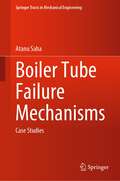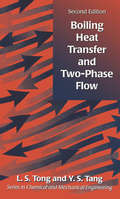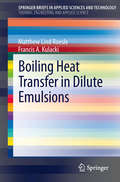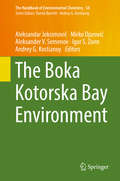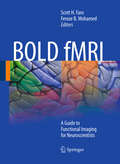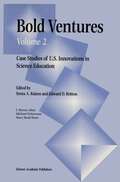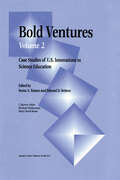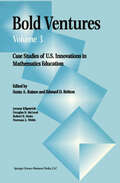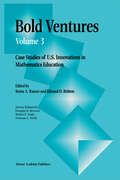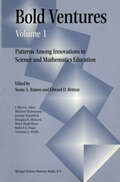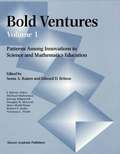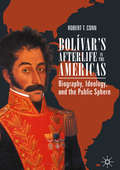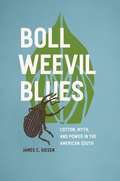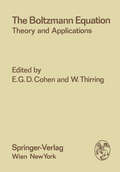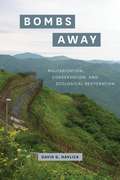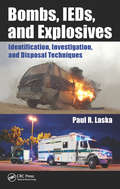- Table View
- List View
Boiler Tube Failure Mechanisms: Case Studies (Springer Tracts in Mechanical Engineering)
by Atanu SahaThis book presents failure mechanisms of different boiler components and preventive measures. It illustrates the basic steam flow and circuit design of steam boiler, boiler design parameters, boiler components materials and their behavior at different temperatures. The book aims to identify the cause(s) of in-service failure of secondary superheater tube, platen superheater tube and furnace water wall tube and also presents the solutions to avoid the future failures. This volume will be of interest to researchers and professionals working in the areas of energy, power generation, electric power plants, thermodynamics, industrial chemistry, etc.
Boiling Heat Transfer And Two-Phase Flow
by L S TongCompletely updated, this graduate text describes the current state of boiling heat transfer and two-phase flow, in terms through which students can attain a consistent understanding. Prediction of real or potential boiling heat transfer behaviour, both in steady and transient states, is covered to aid engineering design of reliable and effective systems.
Boiling Heat Transfer And Two-Phase Flow
by L S TongCompletely updated, this graduate text describes the current state of boiling heat transfer and two-phase flow, in terms through which students can attain a consistent understanding. Prediction of real or potential boiling heat transfer behaviour, both in steady and transient states, is covered to aid engineering design of reliable and effective systems.
Boiling Heat Transfer in Dilute Emulsions (SpringerBriefs in Applied Sciences and Technology)
by Matthew Lind Roesle Francis A. KulackiBoiling Heat Transfer in Dilute Emulsions synthesizes recent advances and established understanding on the subject of boiling in dilute emulsions. Experimental results from various sources are collected and analyzed, including contemporary experiments that correlate visualization with heat transfer data. Published models of boiling heat transfer in dilute emulsions, and their implementation, are described and assessed against experimental data.
Boiling liquid maintaining it's temperature (Graph) (tactile)
by Sheffield Vi ServiceThis is a graph showing how a boiling liquid remains at a constant temperature.
The Boka Kotorska Bay Environment (The Handbook of Environmental Chemistry #54)
by Aleksandar Joksimović Mirko Djurović Aleksander V. Semenov Igor S. Zonn Andrey G. KostianoyThis book focuses on environmental aspects of Boka Kotorska Bay in Montenegro (South Adriatic Sea), an area that has been shaped by seasonal tourism, and explores the use and limitations of its natural resources. The individual chapters highlight its geographic and oceanographic characteristics, climate, history and development, biology, fisheries, agriculture, coastal zones, shipping, marine tourism and pollution. Above all, the environmental impact of tourism on marine, coastal and shoreline areas and the resulting conflicts are discussed in detail. The volume is intended for specialists working in various fields of environmental sciences and ecology, water resources and management, land reclamation and agriculture, and regional climate change.
BOLD fMRI: A Guide to Functional Imaging for Neuroscientists
by Scott H. H. Faro Feroze B. B. MohamedFunctional magnetic resonance imaging (fMRI) measures quick, tiny metabolic changes that take place in the brain, providing the most sensitive method currently available for identifying, investigating, and monitoring brain tumors, stroke, and chronic disorders of the nervous system like multiple sclerosis, and brain abnormalities related to dementia or seizures. This overview explains the principles of fMRI, scanning methodlogies, experimental design and data analysis, and outlines challenges and limitations of fMRI. It also provides a detailed neuroanatomic atlas, and describes clinical applications of fMRI in cognitive, sensory, and motor cases, translating research into clinical application.
Bold Ventures: Volume 2 Case Studies of U.S. Innovations in Science Education
by Edward D. Britton Senta A. RaizenThis book presents comprehensive results from case studies of five innovations in science education that have much to offer toward understanding current reforms in this field. Each chapter tells the story of a case in rich detail, with extensive documentation, and in the voices of many of the participants-the innovators, the teachers, the students. Similarly, Volume 3 of Bold Ventures pre sents the results from case studies of five innovations in mathematics education. Volume 1 provides a cross-case analysis of all eight innovations. Many U.S. readers certainly will be very familiar with the name of at least one if not all of the science innovations discussed in this volume-for example, Project 2061-and probably with their general substance. Much of the education community's familiarity with these arises from the projects' own dissemination efforts. The research reported in this volume, however, is one of the few detailed studies of these innovations undertaken by researchers outside the projects them selves. Each of the five studies was a large-scale effort involving teams of researchers over three years. These teams analyzed many documents, attended numerous critical project meetings, visited multiple sites, conducted dozens of individual interviews. The team leaders (Atkin, Huberman, Rowe), having spent much time with science education over long careers, looked at these innovations through many lenses. It was a daunting task for each team to sift through the mountains of detail in order to bring the most compelling themes to the surface.
Bold Ventures: Volume 2 Case Studies of U.S. Innovations in Science Education
by Senta A. Raizen Edward D. BrittonThis book presents comprehensive results from case studies of five innovations in science education that have much to offer toward understanding current reforms in this field. Each chapter tells the story of a case in rich detail, with extensive documentation, and in the voices of many of the participants-the innovators, the teachers, the students. Similarly, Volume 3 of Bold Ventures pre sents the results from case studies of five innovations in mathematics education. Volume 1 provides a cross-case analysis of all eight innovations. Many U.S. readers certainly will be very familiar with the name of at least one if not all of the science innovations discussed in this volume-for example, Project 206l-and probably with their general substance. Much of the education community's familiarity with these arises from the projects' own dissemination efforts. The research reported in this volume, however, is one of the few detailed studies of these innovations undertaken by researchers outside the projects them selves. Each of the five studies was a large-scale effort involving teams of researchers over three years. These teams analyzed many documents, attended numerous critical project meetings, visited multiple sites, conducted dozens of individual interviews. The team leaders (Atkin, Huberman, Rowe), having spent much time with science education over long careers, looked at these innovations through many lenses. It was a daunting task for each team to sift through the mountains of detail in order to bring the most compelling themes to the surface.
Bold Ventures: Case Studies of U.S. Innovations in Mathematics Education (Bold Ventures #3)
by Senta A. Raizen and Edward D. BrittonThis book presents comprehensive results from case studies of three innovations in mathematics education that have much to offer toward understanding current reforms in this field. Each chapter tells the story of a case in rich detail, with extensive documentation, and in the voices of many of the participants-the innovators, the teachers, the students. Similarly, Volume 2 of Bold Ventures pre sents the results from case studies of five innovations in science education. Volume 1 provides a cross-case analysis of all eight innovations. Many U.S. readers certainly will be very familiar with the name of at least one if not all of the mathematics innovations discussed in this volume-for example, the NCTM Standards-and probably with their general substance. Much of the education community's familiarity with these arises from the pro jects' own dissemination efforts. The research reported in this volume, however, is one of the few detailed studies of these innovations undertaken by researchers outside the projects themselves.
Bold Ventures: Case Studies of U.S. Innovations in Mathematics Education
by Senta A. Raizen and Edward D. BrittonThis book presents comprehensive results from case studies of three innovations in mathematics education that have much to offer toward understanding current reforms in this field. Each chapter tells the story of a case in rich detail, with extensi ve documentation, and in the voices of many of the participants-the innovators, the teachers, the students. Similarly, Volume 2 of Bold Ventures pre sents the results from case studies of five innovations in science education. Volume 1 provides a cross-case analysis of all eight innovations. Many U.S. readers certainly will be very familiar with the name of at least if not all of the mathematics innovations discussed in this volume-for one example, the NCTM Standards-and probably with their general substance. Much of the education community's familiarity with these" arises from the pro jects' own dissemination efforts. The research reported in this volume, however, is one of the few detailed studies of these innovations undertaken by researchers outside the projects themselves.
Bold Ventures Volume 1: Patterns Among U.S. Innovations in Science and Mathematics Education
by Edward D. Britton Senta A. RaizenThis book, based on detailed studies of eight innovations in mathematics and science education, has many insights to offer on current school reform. Since each innovation studied has taken its own unique approach, the set as a whole spans the spectrum from curriculum development to systemic reform, from con centrating on particular school populations to addressing all of K-12 education. Yet these reform projects share a common context, a world view on what mat ters in science and mathematics for students of the 1990s and beyond, convic tions about what constitutes effective instruction, and some notions about how school change can be brought about. These commonalities are drawn out in the book and illustrated with examples from the individual case studies that are reported in full in Bold Ventures, Volumes 2 and 3. The eight innovations-all of them projects that are well-known, at least by name, to U. S. audiences-are briefly described in chapter 1. Each was the sub ject of an in-depth, three-year case study. The research teams analyzed many documents, attended numerous project meetings, visited multiple sites, conduct ed dozens of individual interviews. The team leaders, having spent much time with mathematics or science education over long careers, looked at these reform projects through several lenses; the teams sifted through the mountains of data they had collected in order to tell the story of each project in rich detail.
Bold Ventures - Volume 1: Patterns Among Innovations in Science and Mathematics Education (Bold Ventures Ser. #3)
by Senta A. Raizen Edward D. BrittonThis book, based on detailed studies of eight innovations in mathematics and science education, has many insights to offer on current school reform. Since each innovation studied has taken its own unique approach, the set as a whole spans the spectrum from curriculum development to systemic reform, from c- centrating on particular school populations to addressing all of K-12 education. Yet these reform projects share a common context, a world view on what m- ters in science and mathematics for students of the 1990s and beyond, conv- tions about what constitutes effective instruction, and some notions about how school change can be brought about. These commonalities are drawn out in the book and illustrated with examples from the individual case studies that are reportedin full in BoldVentures, Volumes 2 and 3. The eight innovations—all of them projects that are well-known, at least by name, to U. S. audiences—are briefly described in chapter 1. Each was the s- ject of an in-depth, three-year case study. The research teams analyzed many documents, attended numerous project meetings, visited multiple sites, condu- ed dozens of individual interviews. The team leaders, having spent much time with mathematics or science education over long careers, looked at these reform projects through several lenses; the teams sifted through the mountains of data they had collected in order to tell the story of each project in rich detail.
The Boletes of China: Tylopilus s.l.
by Yan-Chun Li Zhu L. YangThis book introduces the Chinese boletes, including the history, ecological and economic values, as well as the geographical distribution patterns with a highlight on the Tylopilus species. Species in Tylopilus s.l. are not only of important ecological values but also of scientific interests. They are very diverse in morphology, complex in structure and wide in ecological niches. China is one of the diverse hotspots of boletes, and many boletes were traditionally treated as members of Tylopilus based on hymenophore or spore-print colour. The studies revealed that the traditionally defined Tylopilus is polyphyletic. This book aims to elucidate the phylogenetic relationships among the genera treated in Tylopilus s.l. previously; to delimit and recognize the taxa, and finally to reveal the diversity of the genera and species of Tylopilus s.l. in China. The book is intended to be a reference for biologists who conduct investigations of biological resources and biodiversity; university and college teachers and students carrying out studies in related fields; mycologists and amateur mycologists, or people who interested in mushrooms taxonomy and systematics; and workers in the development of non-timber forest products.
Bolívar’s Afterlife in the Americas: Biography, Ideology, and the Public Sphere
by Robert T. ConnSimón Bolívar is the preeminent symbol of Latin America and the subject of seemingly endless posthumous attention. Interpreted and reinterpreted in biographies, histories, political writings, speeches, and works of art and fiction, he has been a vehicle for public discourse for the past two centuries. Robert T. Conn follows the afterlives of Bolívar across the Americas, tracing his presence in a range of competing but interlocking national stories. How have historians, writers, statesmen, filmmakers, and institutions reworked his life and writings to make cultural and political claims? How has his legacy been interpreted in the countries whose territories he liberated, as well as in those where his importance is symbolic, such as the United States? In answering these questions, Conn illuminates the history of nation building and hemispheric globalism in the Americas.
Boll Weevil Blues: Cotton, Myth, and Power in the American South
by James C. GiesenBetween the 1890s and the early 1920s, the boll weevil slowly ate its way across the Cotton South from Texas to the Atlantic Ocean. At the turn of the century, some Texas counties were reporting crop losses of over 70 percent, as were areas of Louisiana, Arkansas, and Mississippi. By the time the boll weevil reached the limits of the cotton belt, it had destroyed much of the region’s chief cash crop—tens of billions of pounds of cotton, worth nearly a trillion dollars. As staggering as these numbers may seem, James C. Giesen demonstrates that it was the very idea of the boll weevil and the struggle over its meanings that most profoundly changed the South—as different groups, from policymakers to blues singers, projected onto this natural disaster the consequences they feared and the outcomes they sought. Giesen asks how the myth of the boll weevil’s lasting impact helped obscure the real problems of the region—those caused not by insects, but by landowning patterns, antiquated credit systems, white supremacist ideology, and declining soil fertility. Boll Weevil Blues brings together these cultural, environmental, and agricultural narratives in a novel and important way that allows us to reconsider the making of the modern American South.
Boll Weevil Blues: Cotton, Myth, and Power in the American South
by James C. GiesenBetween the 1890s and the early 1920s, the boll weevil slowly ate its way across the Cotton South from Texas to the Atlantic Ocean. At the turn of the century, some Texas counties were reporting crop losses of over 70 percent, as were areas of Louisiana, Arkansas, and Mississippi. By the time the boll weevil reached the limits of the cotton belt, it had destroyed much of the region’s chief cash crop—tens of billions of pounds of cotton, worth nearly a trillion dollars. As staggering as these numbers may seem, James C. Giesen demonstrates that it was the very idea of the boll weevil and the struggle over its meanings that most profoundly changed the South—as different groups, from policymakers to blues singers, projected onto this natural disaster the consequences they feared and the outcomes they sought. Giesen asks how the myth of the boll weevil’s lasting impact helped obscure the real problems of the region—those caused not by insects, but by landowning patterns, antiquated credit systems, white supremacist ideology, and declining soil fertility. Boll Weevil Blues brings together these cultural, environmental, and agricultural narratives in a novel and important way that allows us to reconsider the making of the modern American South.
Boll Weevil Blues: Cotton, Myth, and Power in the American South
by James C. GiesenBetween the 1890s and the early 1920s, the boll weevil slowly ate its way across the Cotton South from Texas to the Atlantic Ocean. At the turn of the century, some Texas counties were reporting crop losses of over 70 percent, as were areas of Louisiana, Arkansas, and Mississippi. By the time the boll weevil reached the limits of the cotton belt, it had destroyed much of the region’s chief cash crop—tens of billions of pounds of cotton, worth nearly a trillion dollars. As staggering as these numbers may seem, James C. Giesen demonstrates that it was the very idea of the boll weevil and the struggle over its meanings that most profoundly changed the South—as different groups, from policymakers to blues singers, projected onto this natural disaster the consequences they feared and the outcomes they sought. Giesen asks how the myth of the boll weevil’s lasting impact helped obscure the real problems of the region—those caused not by insects, but by landowning patterns, antiquated credit systems, white supremacist ideology, and declining soil fertility. Boll Weevil Blues brings together these cultural, environmental, and agricultural narratives in a novel and important way that allows us to reconsider the making of the modern American South.
Boll Weevil Blues: Cotton, Myth, and Power in the American South
by James C. GiesenBetween the 1890s and the early 1920s, the boll weevil slowly ate its way across the Cotton South from Texas to the Atlantic Ocean. At the turn of the century, some Texas counties were reporting crop losses of over 70 percent, as were areas of Louisiana, Arkansas, and Mississippi. By the time the boll weevil reached the limits of the cotton belt, it had destroyed much of the region’s chief cash crop—tens of billions of pounds of cotton, worth nearly a trillion dollars. As staggering as these numbers may seem, James C. Giesen demonstrates that it was the very idea of the boll weevil and the struggle over its meanings that most profoundly changed the South—as different groups, from policymakers to blues singers, projected onto this natural disaster the consequences they feared and the outcomes they sought. Giesen asks how the myth of the boll weevil’s lasting impact helped obscure the real problems of the region—those caused not by insects, but by landowning patterns, antiquated credit systems, white supremacist ideology, and declining soil fertility. Boll Weevil Blues brings together these cultural, environmental, and agricultural narratives in a novel and important way that allows us to reconsider the making of the modern American South.
The Boltzmann Equation: Theory and Applications (Few-Body Systems #10/1973)
by E. G. D. Cohen W. ThirringIn,1872, Boltzmann published a paper which for the first time provided a precise mathematical basis for a discussion of the approach to equilibrium. The paper dealt with the approach to equilibrium of a dilute gas and was based on an equation - the Boltzmann equation, as we call it now - for the velocity distribution function of such ~ gas. The Boltzmann equation still forms the basis of the kinetic theory of gases and has proved fruitful not only for the classical gases Boltzmann had in mind, but als- if properly generalized - for the electron gas in a solid and the excitation gas in a superfluid. Therefore it was felt by many of us that the Boltzmann equation was of sufficient interest, even today, to warrant a meeting, in which a review of its present status would be undertaken. Since Boltzmann had spent a good part of his life in Vienna, this city seemed to be a natural setting for such a meeting. The first day was devoted to historical lectures, since it was generally felt that apart from their general interest, they would furnish a good introduction to the subsequent scientific sessions. We are very much indebted to Dr. D.
Bombs Away: Militarization, Conservation, and Ecological Restoration
by David G. HavlickWhen viewed from space, the Korean Peninsula is crossed by a thin green ribbon. On the ground, its mix of dense vegetation and cleared borderlands serves as home to dozens of species that are extinct or endangered elsewhere on the peninsula. This is Korea’s demilitarized zone—one of the most dangerous places on earth for humans, and paradoxically one of the safest for wildlife. Although this zone was not intentionally created for conservation, across the globe hundreds of millions of acres of former military zones and bases are being converted to restoration areas, refuges, and conservation lands. David G. Havlick has traveled the world visiting these spaces of military-to-wildlife transition, and in Bombs Away he explores both the challenges—physical, historical, and cultural—and fascinating ecological possibilities of military site conversions. Looking at particular international sites of transition—from Indiana’s Big Oaks National Wildlife Refuge to Cold War remnants along the former Iron Curtain—Havlick argues that these new frontiers of conservation must accomplish seemingly antithetical aims: rebuilding and protecting ecosystems, or restoring life, while also commemorating the historical and cultural legacies of warfare and militarization. Developing these ideas further, he shows that despite the ecological devastation often wrought by military testing and training, these activities need not be inconsistent with environmental goals, and in some cases can even complement them—a concept he calls ecological militarization. A profound, clear explication of landscapes both fraught and fecund, marked by death but also reservoirs of life, Bombs Away shows us how “military activities, conservation goals, and ecological restoration efforts are made to work together to create new kinds of places and new conceptions of place.”
Bombs Away: Militarization, Conservation, and Ecological Restoration
by David G. HavlickWhen viewed from space, the Korean Peninsula is crossed by a thin green ribbon. On the ground, its mix of dense vegetation and cleared borderlands serves as home to dozens of species that are extinct or endangered elsewhere on the peninsula. This is Korea’s demilitarized zone—one of the most dangerous places on earth for humans, and paradoxically one of the safest for wildlife. Although this zone was not intentionally created for conservation, across the globe hundreds of millions of acres of former military zones and bases are being converted to restoration areas, refuges, and conservation lands. David G. Havlick has traveled the world visiting these spaces of military-to-wildlife transition, and in Bombs Away he explores both the challenges—physical, historical, and cultural—and fascinating ecological possibilities of military site conversions. Looking at particular international sites of transition—from Indiana’s Big Oaks National Wildlife Refuge to Cold War remnants along the former Iron Curtain—Havlick argues that these new frontiers of conservation must accomplish seemingly antithetical aims: rebuilding and protecting ecosystems, or restoring life, while also commemorating the historical and cultural legacies of warfare and militarization. Developing these ideas further, he shows that despite the ecological devastation often wrought by military testing and training, these activities need not be inconsistent with environmental goals, and in some cases can even complement them—a concept he calls ecological militarization. A profound, clear explication of landscapes both fraught and fecund, marked by death but also reservoirs of life, Bombs Away shows us how “military activities, conservation goals, and ecological restoration efforts are made to work together to create new kinds of places and new conceptions of place.”
Bombs Away: Militarization, Conservation, and Ecological Restoration
by David G. HavlickWhen viewed from space, the Korean Peninsula is crossed by a thin green ribbon. On the ground, its mix of dense vegetation and cleared borderlands serves as home to dozens of species that are extinct or endangered elsewhere on the peninsula. This is Korea’s demilitarized zone—one of the most dangerous places on earth for humans, and paradoxically one of the safest for wildlife. Although this zone was not intentionally created for conservation, across the globe hundreds of millions of acres of former military zones and bases are being converted to restoration areas, refuges, and conservation lands. David G. Havlick has traveled the world visiting these spaces of military-to-wildlife transition, and in Bombs Away he explores both the challenges—physical, historical, and cultural—and fascinating ecological possibilities of military site conversions. Looking at particular international sites of transition—from Indiana’s Big Oaks National Wildlife Refuge to Cold War remnants along the former Iron Curtain—Havlick argues that these new frontiers of conservation must accomplish seemingly antithetical aims: rebuilding and protecting ecosystems, or restoring life, while also commemorating the historical and cultural legacies of warfare and militarization. Developing these ideas further, he shows that despite the ecological devastation often wrought by military testing and training, these activities need not be inconsistent with environmental goals, and in some cases can even complement them—a concept he calls ecological militarization. A profound, clear explication of landscapes both fraught and fecund, marked by death but also reservoirs of life, Bombs Away shows us how “military activities, conservation goals, and ecological restoration efforts are made to work together to create new kinds of places and new conceptions of place.”
Bombs Away: Militarization, Conservation, and Ecological Restoration
by David G. HavlickWhen viewed from space, the Korean Peninsula is crossed by a thin green ribbon. On the ground, its mix of dense vegetation and cleared borderlands serves as home to dozens of species that are extinct or endangered elsewhere on the peninsula. This is Korea’s demilitarized zone—one of the most dangerous places on earth for humans, and paradoxically one of the safest for wildlife. Although this zone was not intentionally created for conservation, across the globe hundreds of millions of acres of former military zones and bases are being converted to restoration areas, refuges, and conservation lands. David G. Havlick has traveled the world visiting these spaces of military-to-wildlife transition, and in Bombs Away he explores both the challenges—physical, historical, and cultural—and fascinating ecological possibilities of military site conversions. Looking at particular international sites of transition—from Indiana’s Big Oaks National Wildlife Refuge to Cold War remnants along the former Iron Curtain—Havlick argues that these new frontiers of conservation must accomplish seemingly antithetical aims: rebuilding and protecting ecosystems, or restoring life, while also commemorating the historical and cultural legacies of warfare and militarization. Developing these ideas further, he shows that despite the ecological devastation often wrought by military testing and training, these activities need not be inconsistent with environmental goals, and in some cases can even complement them—a concept he calls ecological militarization. A profound, clear explication of landscapes both fraught and fecund, marked by death but also reservoirs of life, Bombs Away shows us how “military activities, conservation goals, and ecological restoration efforts are made to work together to create new kinds of places and new conceptions of place.”
Bombs, IEDs, and Explosives: Identification, Investigation, and Disposal Techniques
by Paul R. LaskaA guide on procedures, administration, and equipment, Bombs, IEDs, and Explosives: Identification, Investigation, and Disposal Techniques introduces concepts, basic knowledge, and necessary skill sets for bomb technicians. It covers topics such as training resources, bomb threat and incident response, legal aspects of bomb disposal, explosives and
